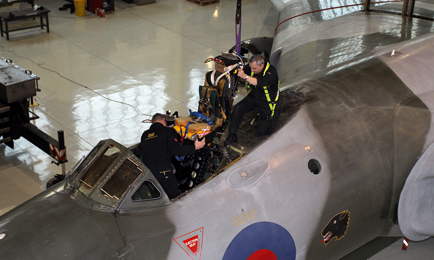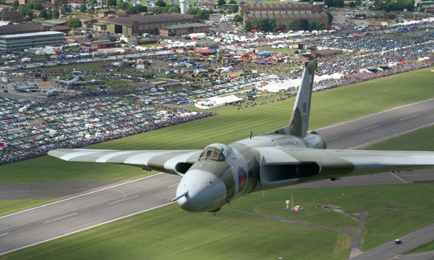Cold War warrior: Millions of pounds have been raised to keep the plane airworthy
The Vulcan bomber was a mainstay of Britain’s nuclear deterrent during the Cold War. Today the last remaining flying Vulcan – XH558 – is maintained at a hangar at Robin Hood Airport in Doncaster and directed towards peaceful ends as a display aircraft.
The spectacle of watching the aircraft in flight may have to cease next year, but the Vulcan to the Sky Trust, the charity that operates the plane, will do everything in its power to keep the show in the skies. If not, alternative uses for the bomber will be found.
For Dr Robert Pleming, the nuclear physicist and former Cisco Systems executive who runs the trust, the final flight of XH558 will be an emotional one.
Pleming has been involved in the project, which is supported by donations from individuals and industry, as well as £2.7 million from the Heritage Lottery Fund, since the 1990s. XH558, known as the Spirit of Great Britain, is the only airworthy example of the 134 Avro Vulcan V bombers that were operated by the Royal Air Force until 1984. It served in bomber, maritime reconnaissance and air-to-air refuelling roles.
The aircraft was also used for displays from 1986 until 1992, when budget cuts forced its retirement. According to Pleming, “the aeroplane was so liked by the public and was such a good recruiting tool for the RAF that they decided to keep one flying on after the rest of the fleet was disbanded”. He became interested in restoring it to flight in 1997. “We started trying to get it back to flight under civilian regulations. The thing that attracted me was reading up about it and realising what an immense engineering achievement the design had been.”
A distinctive delta-wing strategic bomber, the Vulcan B1 was first delivered to the RAF in 1956. Deliveries of the improved Vulcan B2 – of which XH558 is the 12th example built, but the first to enter service – started in 1960. The B2 featured more powerful engines, a larger wing, an improved electrical system and electronic countermeasures.
As a part of the V-force, the Vulcan was the backbone of the UK’s airborne nuclear deterrent during much of the Cold War. Although the aircraft was typically armed with nuclear weapons, it was capable of conventional bombing missions, and saw action in that role in 1982 in Operation Black Buck during the Falklands War (see box on page 64).
The Vulcan fleet was finally disbanded in 1984. Polaris submarines had taken over from the V-force deterrent in 1969. From that point on, Vulcans were kept in a tactical nuclear role but also for maritime reconnaissance and as a tanker variant, which had air-to-air refuelling capability.

Preparing the cockpit: The Vulcan has at least three crew members in flight
Pleming believes that even a grounded bomber can be used to continue to inspire the next generation of engineers. He is interested in using XH558 as the centrepiece of a new engineering exhibition modelled on the Eden Project in Cornwall. The Eden Project combines gardens, arts and music with social and environmental programmes. He believes the bomber could be used to help train students as part of a new university technical college (UTC), based either at Doncaster or elsewhere – providing there is an airstrip close by.
“It’s the power of working technology that we are focusing our attention on in the long term,” he says. “The aircraft will be kept in running condition and allowed to taxi, she just won’t be allowed to fly.” Working on the plane’s systems could help to train the next generation of aircraft maintenance engineers, Pleming thinks.
“I’ve been told that the average age of the licensed aircraft engineer is 55, so there’s a real problem looming in commercial aircraft maintenance skills,” he says. “When we show youngsters around the Vulcan, it’s such a simple aircraft to explain. We are able to demonstrate some of the principles that modern aircraft use but on something that is a lot simpler.
“And stuff that is hidden on modern airliners is demonstrable on something of heritage origin. This is why we’re now keen to use this as a teaching aid once she has retired from flight.”
He adds that, once grounded, the bomber will be in the best condition of any aircraft of its era. “We need to keep her inside because the materials they used at the time can’t cope with the weather and corrosion – some of the museum Vulcans that are outside are in dreadful condition now.” The engines will be kept operational and powered up for visitors and students. “There are an awful lot of museums around where you can see static exhibits that may be gathering dust,” he says.
There are no complete examples of the original B1 line of bombers left, but there are a couple of cockpit sections.
The intention of the engineering centre or university technical college would be to demonstrate the latest technologies, such as additive layer manufacturing, as well as the Vulcan. “We might want to bring other aircraft such as an Airbus A320 alongside it as an example of modern planes,” says Pleming.
There are already 17 UTCs around the country, and 30 more are scheduled to open by 2016. They are government-funded, and offer 14- to 18-year-olds a different experience from traditional schools. They teach students technical and scientific subjects in a new way.
Doncaster could benefit from a UTC there, and two potential sites have been identified by Peel Group, the owner of Robin Hood Airport. “The catchment area is deprived so a UTC could be good, it could be successful,” says Pleming. He says his preferred name for the proposed UTC is National Technology Centre. “We may be being a bit precocious but you have to dream.”
The tailless delta-wing design seen in the Vulcan bomber and the Gloster Javelin fighter was used later in fighter jets such as the Dassault Mirage III. According to Pleming, XH558 is viewed as “beautiful”. “It is the shape of the curved delta wing,” he says. “It is really extraordinary: she is very agile, has huge wings, and has huge flight control surfaces at the back of the wing.”
The bomber relies on four Rolls-Royce Olympus engines and has control surfaces known as elevons, which make it nimble and controllable. Elevons combine the functions of the elevator, used for pitch control, and the aileron, used for roll control. Concorde also used elevons. The elevons operate in two modes. In aileron mode, flight surfaces on the wings move in opposite directions. In pitch mode, the elevons go down or up together, which pitches the nose down or up.
The Rolls-Royce engines on the Vulcan are twin-spool axial turbojets. They were the first of their type and were developed by Bristol Aero Engines. First running in 1950, their initial use was as the powerplant of the Vulcan. The design was further developed for supersonic performance under the BAC TSR-2 programme. It later saw production as the Rolls-Royce/Snecma Olympus 593 – Concorde’s powerplant.
The engines of XH558, along with the airframe, will have to be proved airworthy beyond 2015, and efforts are being made to maintain the life of both. For example, a long runway, or one in excess of 900m, allows a reduced power take-off to be made, preserving engine life. A program from Rolls-Royce uses an algorithm that converts low-pressure engine rpm into engine life used for each flight, allowing Vulcan to the Sky’s engineers to determine how much flying time the engines have left.
The less adjustment of the throttle in flight, the better. Changing throttle settings consumes engine life. Structural life has been enhanced over the years by modifications to the aircraft’s hull. The ultimate aim will be to use up the aircraft’s structural and engine potential at the same time. “Then it’s game, set and match,” says Pleming.
Although the engineers are unsure whether flying life for the Vulcan can be maintained beyond next year, they will not stop trying to secure it. “We will try to fly as long as we can safely,” says Pleming. “We recognise the huge support of the public – literally hundreds of thousands of people like seeing her fly. I can’t really give a probability on whether it will happen. But I’m endlessly optimistic.”
The support of companies such as Rolls-Royce, BAE Systems and Messier Dowty is crucial to this. Without their input, Vulcan to the Sky would never be able to acquire continued certification to fly from the Civil Aviation Authority.
The fatigue performance of the aircraft is measured against tests done in the 1960s. “They took one airframe and basically put it on a jig and shook it to bits. That’s the way they measured the fatigue life of the structure and that is the thing we are flying in relation to,” says Pleming. In terms of the engines, he says, “Rolls-Royce has given us something that indicates that right now we are confident of getting to 2015. Beyond that, it is a question mark.”
Even if XH558 makes its last flight in 2015, the hope is that its usefulness as an educational and inspirational example of British engineering will remain undimmed, whether through the establishment of a UTC or some other form of outreach involving the bomber.
“We want to energise youngsters to consider engineering as a career – and we are not only talking professional engineers, there’s a whole set at technician level,” he says. He adds that the numbers of boys and girls studying technical subjects at GCSE level are in decline.
“But we think when we finish flying there will be a really good legacy for an educational programme.”

XH558 airbourne: 'Hundreds of thousands of people like to see her fly'
Specialised role in Vulcan's cockpit
There is a minimum of three crew on a Vulcan flight, including two pilots and an air electronics officer. Many of the flying surfaces, controls and other critical systems rely on electricity to a degree unusual for the time when XH558 was designed. “Managing the electricity supply on the Vulcan is a critical role, and that’s what the air electronics officer does,” says Dr Robert Pleming.
The Vulcan to the Sky Trust employs two such officers and a team of five pilots. Two of the pilots work for Virgin in their day jobs. One of the others is the chief test pilot for Rolls-Royce, Phill O’Dell.
Martin Withers DFC is the chief Vulcan pilot. He was famously the captain who dropped bombs on Port Stanley airfield from a Vulcan in the Falklands War. The air electronics officers are former RAF officers and in short supply. “Frankly, these people would be difficult to find otherwise,” says Pleming.
At one stage, 600 companies were involved in overhauling parts for the XH558 when its restoration was taking place in the mid-noughties. Many of these firms’ former employees had worked on the aircraft during its original operating life and had to be brought out of retirement for the restoration. Some have since sadly passed away. “If we started to restore the Vulcan to flight from a standing start now we would find it virtually impossible,” says Pleming.
The exterior of the aircraft is maintained by a dedicated painter so that it is in good condition for display. Pleming has flown in XH558 only once. “It was unique. You can’t really see much out of the cockpit, especially in the rear seats,” he recalls.
“It was something I’ll never forget – an extraordinary experience.”